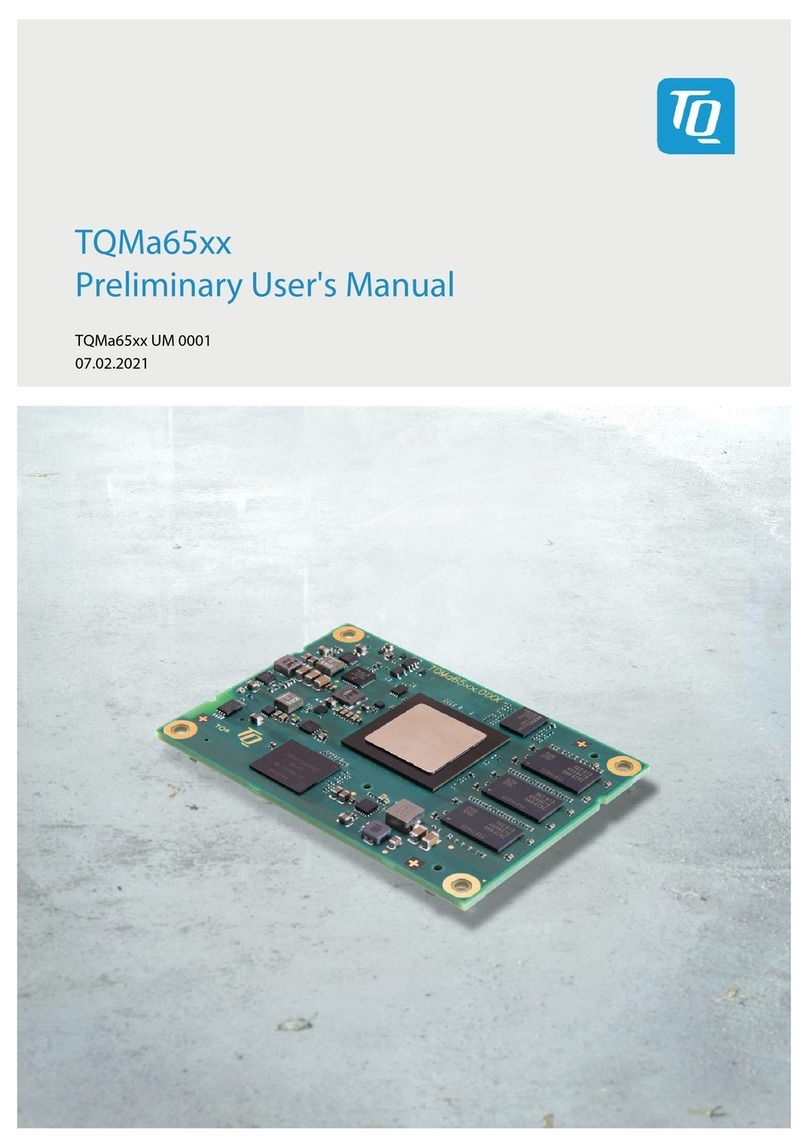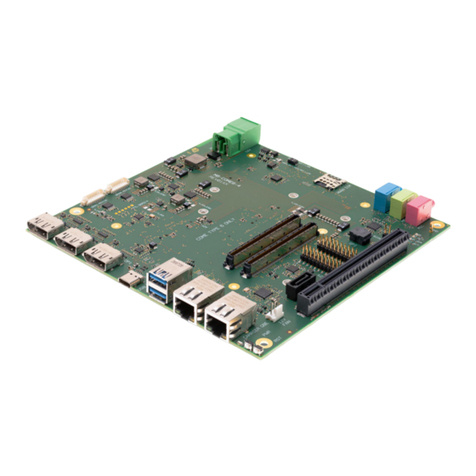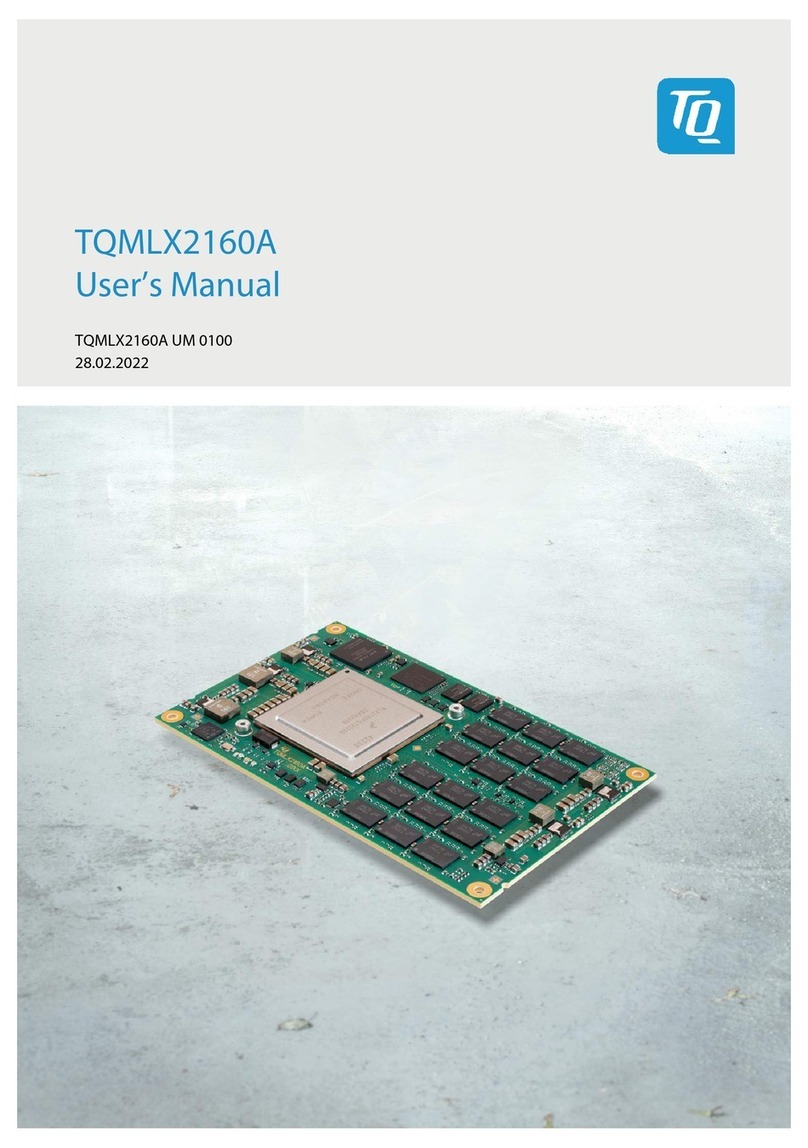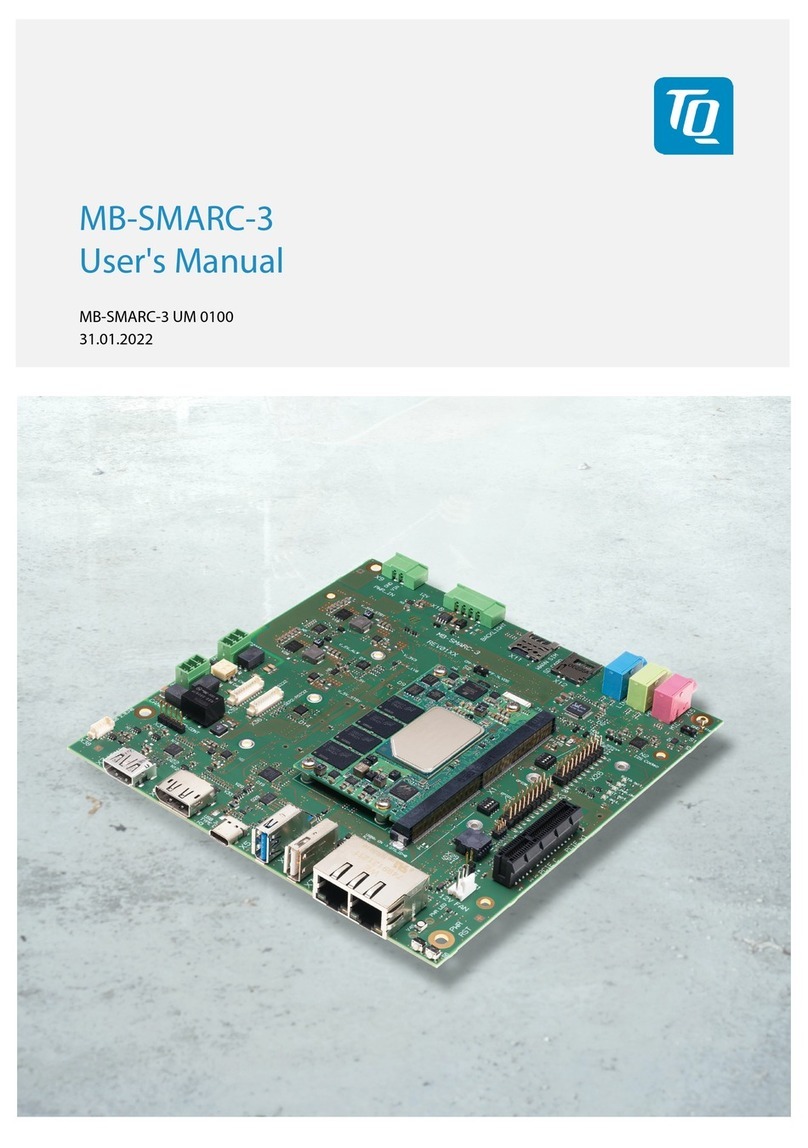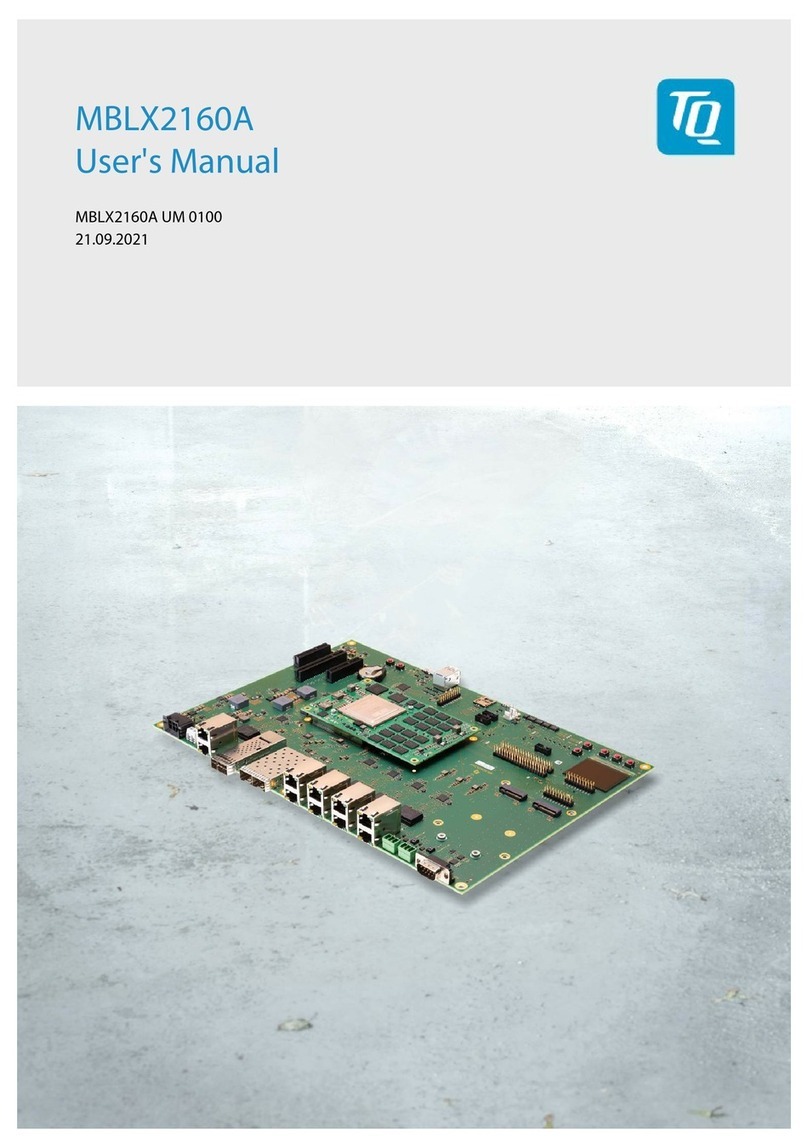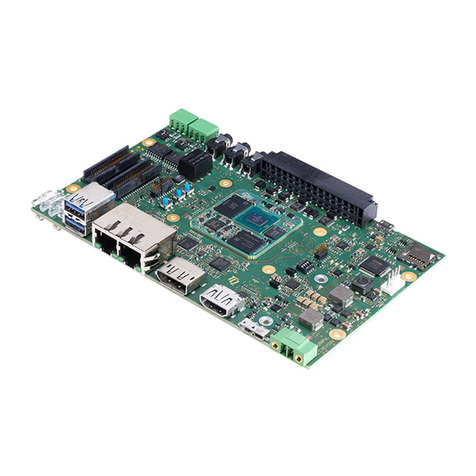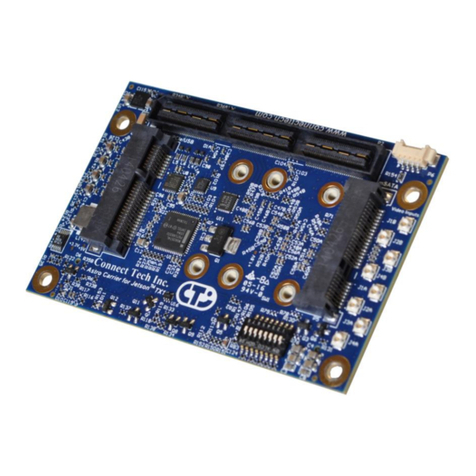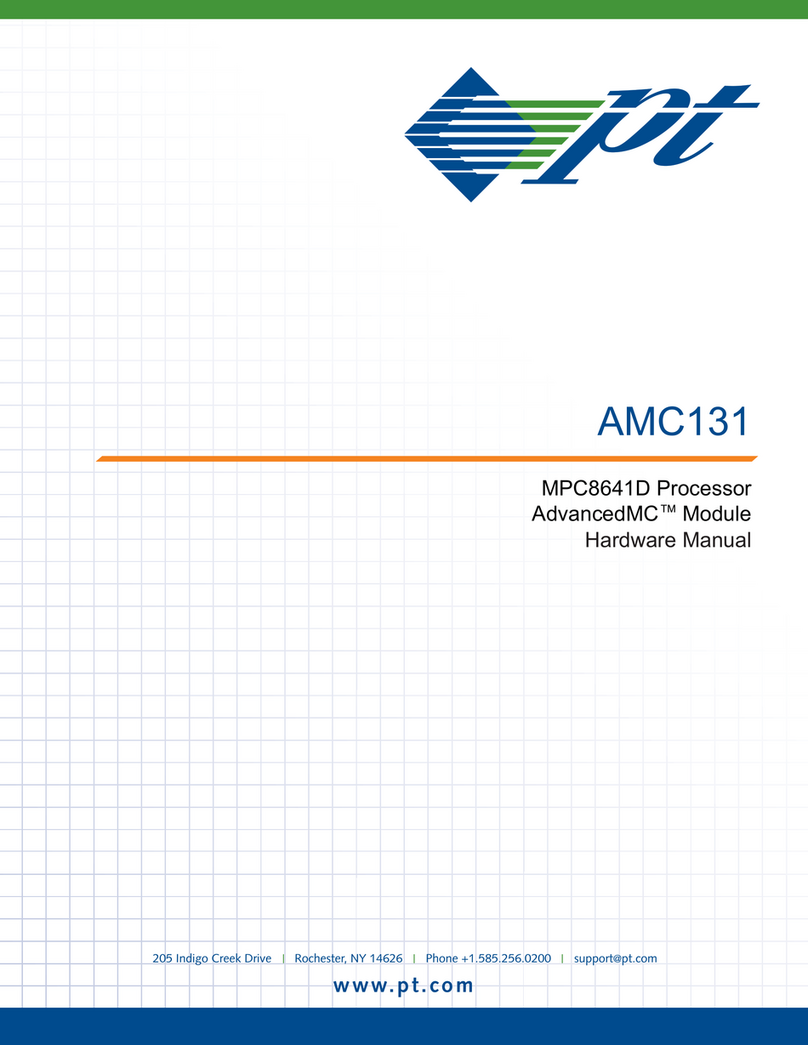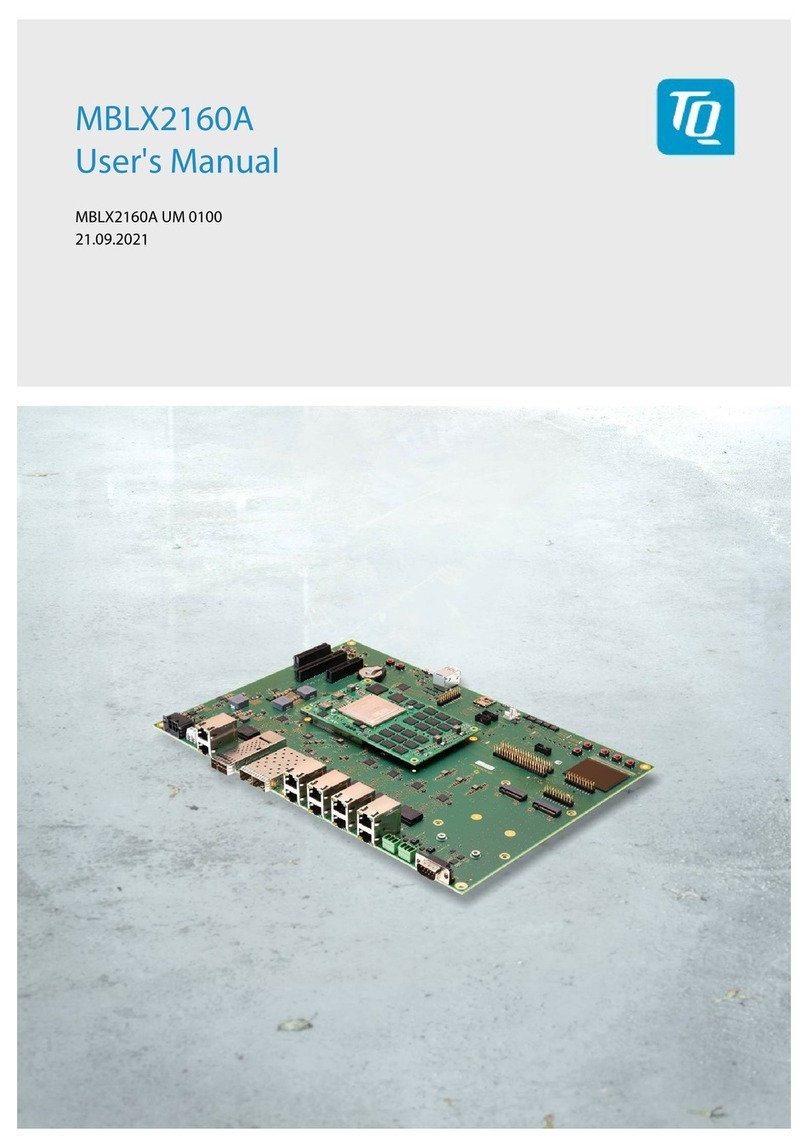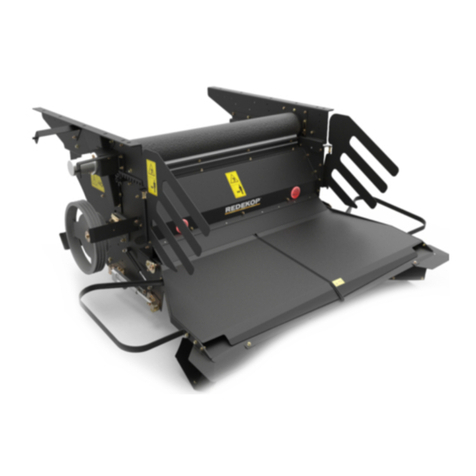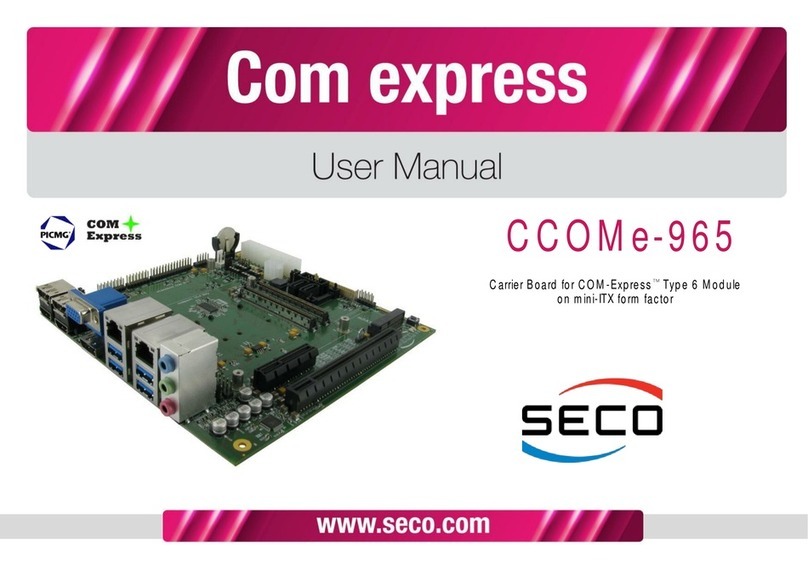TQ MBa8Xx User manual

MBa8Xx
User's Manual
MBa8Xx UM 0100
21.12.2020

User's Manual l MBa8Xx UM 0100 l © 2020, TQ-Systems GmbH Page i
TABLE OF CONTENTS
1. ABOUT THIS MANUAL................................................................................................................................................................................1
1.1 Copyright and license expenses.............................................................................................................................................................1
1.2 Registered trademarks...............................................................................................................................................................................1
1.3 Disclaimer......................................................................................................................................................................................................1
1.4 Imprint............................................................................................................................................................................................................1
1.5 Tips on safety................................................................................................................................................................................................2
1.6 Symbols and typographic conventions ...............................................................................................................................................2
1.7 Handling and ESD tips...............................................................................................................................................................................2
1.8 Naming of signals........................................................................................................................................................................................3
1.9 Further applicable documents / presumed knowledge.................................................................................................................3
2. BRIEF DESCRIPTION ....................................................................................................................................................................................4
2.1 MBa8Xx block diagram..............................................................................................................................................................................4
2.2 MBa8Xx data interfaces.............................................................................................................................................................................5
3. ELECTRONICS................................................................................................................................................................................................6
3.1 TQMa8Xx........................................................................................................................................................................................................6
3.1.1 TQMa8Xx connectors on MBa8Xx..........................................................................................................................................................7
3.1.2 TQMa8Xx pinout..........................................................................................................................................................................................7
3.2 Boot Mode configuration ...................................................................................................................................................................... 11
3.3 I2C devices................................................................................................................................................................................................... 12
3.3.1 Default I2C interface................................................................................................................................................................................. 12
3.3.2 M4 I2C interface......................................................................................................................................................................................... 14
3.3.3 Further I2C devices................................................................................................................................................................................... 14
3.4 GPIO port expander................................................................................................................................................................................. 15
3.5 Temperature sensor and EEPROM ...................................................................................................................................................... 16
3.6 RTC backup................................................................................................................................................................................................. 17
3.7 USB hub....................................................................................................................................................................................................... 18
3.8 Data interfaces .......................................................................................................................................................................................... 20
3.8.1 Audio............................................................................................................................................................................................................ 20
3.8.2 CAN............................................................................................................................................................................................................... 22
3.8.3 Debug USB ................................................................................................................................................................................................. 23
3.8.4 Ethernet....................................................................................................................................................................................................... 24
3.8.5 GPIO.............................................................................................................................................................................................................. 26
3.8.6 Display interfaces..................................................................................................................................................................................... 27
3.8.6.1 eDP / DisplayPort...................................................................................................................................................................................... 27
3.8.6.2 Dual channel LVDS / MIPI_DSI.............................................................................................................................................................. 29
3.8.7 MIPI CSI........................................................................................................................................................................................................ 31
3.8.8 Mini PCIe ..................................................................................................................................................................................................... 33
3.8.9 SIM card....................................................................................................................................................................................................... 35
3.8.10 USB Hub ...................................................................................................................................................................................................... 36
3.8.11 USB 2.0 OTG ............................................................................................................................................................................................... 37
3.8.12 SD card......................................................................................................................................................................................................... 37
3.8.13 MBa8Xx headers ....................................................................................................................................................................................... 38
3.8.14 JTAG.............................................................................................................................................................................................................. 41
3.9 User interfaces........................................................................................................................................................................................... 42
3.9.1 Reset button .............................................................................................................................................................................................. 42
3.9.2 Power button............................................................................................................................................................................................. 42
3.9.3 On/Off button............................................................................................................................................................................................ 42
3.9.4 GPI buttons................................................................................................................................................................................................. 42
3.9.5 Status LEDs................................................................................................................................................................................................. 42
3.10 Power supply............................................................................................................................................................................................. 43
3.10.1 Input protection ....................................................................................................................................................................................... 43
3.10.2 Power sequencing ................................................................................................................................................................................... 45
3.11 Reset structure.......................................................................................................................................................................................... 47

User's Manual l MBa8Xx UM 0100 l © 2020, TQ-Systems GmbH Page ii
TABLE OF CONTENTS (continued)
4. SOFTWARE.................................................................................................................................................................................................. 48
5. MECHANICS................................................................................................................................................................................................ 48
5.1 MBa8Xx dimensions................................................................................................................................................................................ 48
5.2 Notes of treatment................................................................................................................................................................................... 49
5.3 Embedding in the target system......................................................................................................................................................... 49
5.4 Housing ....................................................................................................................................................................................................... 49
5.5 Thermal management............................................................................................................................................................................ 49
5.6 Assembly..................................................................................................................................................................................................... 51
5.7 Position of interfaces............................................................................................................................................................................... 53
6. SAFETY REQUIREMENTS AND PROTECTIVE REGULATIONS......................................................................................................... 55
6.1 EMC............................................................................................................................................................................................................... 55
6.2 ESD................................................................................................................................................................................................................ 55
6.3 Operational safety and personal security......................................................................................................................................... 55
7. CLIMATIC AND OPERATIONAL CONDITIONS................................................................................................................................... 55
7.1 Protection against external effects..................................................................................................................................................... 55
7.2 Reliability and service life....................................................................................................................................................................... 55
8. ENVIRONMENT PROTECTION................................................................................................................................................................ 56
8.1 RoHS............................................................................................................................................................................................................. 56
8.2 WEEE®.......................................................................................................................................................................................................... 56
8.3 REACH®........................................................................................................................................................................................................ 56
8.4 EuP................................................................................................................................................................................................................ 56
8.5 Packaging ................................................................................................................................................................................................... 56
8.6 Batteries ...................................................................................................................................................................................................... 56
8.6.1 General notes ............................................................................................................................................................................................ 56
8.6.2 Lithium batteries...................................................................................................................................................................................... 56
8.7 Other entries.............................................................................................................................................................................................. 56
9. APPENDIX ................................................................................................................................................................................................... 57
9.1 Acronyms and definitions...................................................................................................................................................................... 57
9.2 References.................................................................................................................................................................................................. 59

User's Manual l MBa8Xx UM 0100 l © 2020, TQ-Systems GmbH Page iii
TABLE DIRECTORY
Table 1: Terms and Conventions ............................................................................................................................................................................2
Table 2: Data interfaces .............................................................................................................................................................................................5
Table 3: Diagnostic and user interfaces................................................................................................................................................................5
Table 4: Connectors assembled on MBa8Xx .......................................................................................................................................................7
Table 5: Carrier board mating connectors...........................................................................................................................................................7
Table 6: Pinout TQMa8Xx connector X1...............................................................................................................................................................8
Table 7: Pinout TQMa8Xx connector X2...............................................................................................................................................................9
Table 8: Pinout TQMa8Xx connector X3............................................................................................................................................................ 10
Table 9: Boot Mode configuration ...................................................................................................................................................................... 11
Table 10: I2C devices, address mapping on TQMa8Xx and MBa8Xx ........................................................................................................... 13
Table 11: Assembly option I2C1 / I2C2 bus for I²C devices on MBa8Xx ..................................................................................................... 14
Table 12: Port expander functions......................................................................................................................................................................... 15
Table 13: Assembly option I²C address GPIO port expander......................................................................................................................... 15
Table 14: Assembly option I²C address temperature sensor / EEPROM..................................................................................................... 16
Table 15: Pinout RTC backup (X7).......................................................................................................................................................................... 17
Table 16: Assembly option RTC-Backup .............................................................................................................................................................. 17
Table 17: USB hub Power Management .............................................................................................................................................................. 19
Table 18: Assembly option Reset USB hub ......................................................................................................................................................... 19
Table 19: Assembly option I2C1 bus am USB hub............................................................................................................................................ 19
Table 20: Pinout Audio (X8, X9, X10)..................................................................................................................................................................... 20
Table 21: Mic (X8), Line-In (X9), Line-Out or Headphone (X10) .................................................................................................................... 21
Table 22: Assembly option Line-Out / Headphone.......................................................................................................................................... 21
Table 23: CAN termination....................................................................................................................................................................................... 22
Table 24: Pinout CAN0 / 1 (X11, X12).................................................................................................................................................................... 22
Table 25: Reset and interrupt signals.................................................................................................................................................................... 24
Table 26: Standard configuration of Ethernet transceivers (boot straps) ................................................................................................. 25
Table 27: Ethernet-LEDs............................................................................................................................................................................................ 25
Table 28: Characteristics Ethernet 1 / 2 (X18, X19)........................................................................................................................................... 25
Table 29: GPIO TQMa8Xx.......................................................................................................................................................................................... 26
Table 30: Supply voltage (V_3V3_MB) at eDP / DisplayPort (X23)............................................................................................................... 28
Table 31: Assembly option I²C address eDP bridge ......................................................................................................................................... 28
Table 32: Pinout LVDS (X14) .................................................................................................................................................................................... 30
Table 33: Pinout LVDS (X22) .................................................................................................................................................................................... 31
Table 34: Pinout MIPI-CSI (X28) .............................................................................................................................................................................. 32
Table 35: Reset- and Interrupt signals of Ethernet-Transceiver.................................................................................................................... 33
Table 36: V_1V5_MPCIE, V_3V3_MPCIE at Mini PCIe (X24) ............................................................................................................................ 33
Table 37: Pinout Mini PCIe (X24) ............................................................................................................................................................................ 34
Table 38: Assembly option Mini PCIe reference clock..................................................................................................................................... 35
Table 39: Assembly option Spread Spectrum of the Mini PCIe reference clock...................................................................................... 35
Table 40: Assembly option I2C1 bus at Mini PCIe clock generator ............................................................................................................. 35
Table 41: Power consumption headers ............................................................................................................................................................... 38
Table 42: Pinout Header X4 ..................................................................................................................................................................................... 39
Table 43: Pinout Header X5 ..................................................................................................................................................................................... 40
Table 44: Pinout JTAG (X15)..................................................................................................................................................................................... 41
Table 45: Assembly option Supply voltage JTAG.............................................................................................................................................. 41
Table 46: General Purpose buttons....................................................................................................................................................................... 42
Table 47: Status-LEDs................................................................................................................................................................................................. 42
Table 48: Supply voltage V_24V_IN at Power-In (X26, X27) .......................................................................................................................... 43
Table 49: Pinout Power-In (X26, X27).................................................................................................................................................................... 44
Table 50: Power-Sequencing .................................................................................................................................................................................. 46
Table 51: Assembly option 1.8 V regulator......................................................................................................................................................... 46
Table 52: RESET_IN# (affects JTAG_SRST# at X15)............................................................................................................................................ 47
Table 53: RESET_OUT# (at X5)................................................................................................................................................................................. 47
Table 54: Labels on MBa8Xx.................................................................................................................................................................................... 51
Table 55: Climatic and operational conditions MBa8Xx................................................................................................................................. 55
Table 56: Acronyms.................................................................................................................................................................................................... 57
Table 57: Further applicable documents............................................................................................................................................................. 59

User's Manual l MBa8Xx UM 0100 l © 2020, TQ-Systems GmbH Page iv
FIGURE DIRECTORY
Figure 1: Block diagram MBa8Xx..............................................................................................................................................................................4
Figure 2: Block diagram TQMa8Xx...........................................................................................................................................................................6
Figure 3: Block diagram I2C bus ............................................................................................................................................................................. 12
Figure 4: Block diagram GPIO expander ............................................................................................................................................................. 15
Figure 5: Block diagram temperature sensor .................................................................................................................................................... 16
Figure 6: Block diagram RTC backup.................................................................................................................................................................... 17
Figure 7: Block diagram USB hub.......................................................................................................................................................................... 18
Figure 8: Block diagram Audio............................................................................................................................................................................... 20
Figure 9: Pinout 3.5 mm jack .................................................................................................................................................................................. 20
Figure 10: Block diagram CAN.................................................................................................................................................................................. 22
Figure 11: Block diagram USB debug..................................................................................................................................................................... 23
Figure 12: Block diagram Ethernet.......................................................................................................................................................................... 24
Figure 13: Block diagram DisplayPort / eDP......................................................................................................................................................... 27
Figure 14: Block diagram Dual-Channel LVDS..................................................................................................................................................... 29
Figure 15: Block diagram MIPI CSI........................................................................................................................................................................... 31
Figure 16: Block diagram Mini PCIe......................................................................................................................................................................... 33
Figure 17: Block diagram USB Hub.......................................................................................................................................................................... 36
Figure 18: Block diagram USB OTG ......................................................................................................................................................................... 37
Figure 19: Block diagram SD card............................................................................................................................................................................ 37
Figure 20: Block diagram JTAG................................................................................................................................................................................. 41
Figure 21: Block diagram Power-In......................................................................................................................................................................... 43
Figure 22: Block diagram MBa8Xx power supply ............................................................................................................................................... 44
Figure 23: Block diagram Enable signals for Power Sequencing................................................................................................................... 45
Figure 24: Power-Sequencing .................................................................................................................................................................................. 46
Figure 25: Block diagram Reset................................................................................................................................................................................ 47
Figure 26: MBa8Xx dimensions................................................................................................................................................................................ 48
Figure 27: TQMa8Xx heat sink mounting holes.................................................................................................................................................. 50
Figure 28: MBa8Xx component placement top.................................................................................................................................................. 51
Figure 29: MBa8Xx component placement bottom.......................................................................................................................................... 52
Figure 30: MBa8Xx interfaces top............................................................................................................................................................................ 53
Figure 31: MBa8Xx interfaces bottom.................................................................................................................................................................... 54
REVISION HISTORY
Rev. Date Name Pos. Modification
0100 21.12.2020 Petz First edition

User's Manual l MBa8Xx UM 0100 l © 2020, TQ-Systems GmbH Page 1
1. ABOUT THIS MANUAL
1.1 Copyright and license expenses
Copyright protected © 2020 by TQ-Systems GmbH.
This User's Manual may not be copied, reproduced, translated, changed or distributed, completely or partially in electronic,
machine readable, or in any other form without the written consent of TQ-Systems GmbH.
The drivers and utilities for the components used as well as the BIOS are subject to the copyrights of the respective
manufacturers. The licence conditions of the respective manufacturer are to be adhered to.
Bootloader-licence expenses are paid by TQ-Systems GmbH and are included in the price.
Licence expenses for the operating system and applications are not taken into consideration and must be calculated / declared
separately.
1.2 Registered trademarks
TQ-Systems GmbH aims to adhere to copyrights of all graphics and texts used in all publications, and strives to use original
or license-free graphics and texts.
All brand names and trademarks mentioned in this User's Manual, including those protected by a third party, unless specified
otherwise in writing, are subjected to the specifications of the current copyright laws and the proprietary laws of the present
registered proprietor without any limitation. One should conclude that brand and trademarks are rightly protected by a third
party.
1.3 Disclaimer
TQ-Systems GmbH does not guarantee that the information in this User's Manual is up-to-date, correct, complete or of good
quality. Nor does TQ-Systems GmbH assume guarantee for further usage of the information. Liability claims against TQ-Systems
GmbH, referring to material or non-material related damages caused, due to usage or non-usage of the information given in this
User's Manual, or due to usage of erroneous or incomplete information, are exempted, as long as there is no proven intentional
or negligent fault of TQ-Systems GmbH.
TQ-Systems GmbH explicitly reserves the rights to change or add to the contents of this User's Manual or parts of it without
special notification.
Important Notice:
Before using the MBa8Xx or parts of the MBa8Xx schematics, you must evaluate it and determine if it is suitable for your intended
application. You assume all risks and liability associated with such use. TQ-Systems GmbH makes no other warranties including,
but not limited to, any implied warranty of merchantability or fitness for a particular purpose. Except where prohibited by law,
TQ-Systems GmbH will not be liable for any indirect, special, incidental or consequential loss or damage arising from the usage of
the MBa8Xx or schematics used, regardless of the legal theory asserted.
1.4 Imprint
TQ-Systems GmbH
Gut Delling, Mühlstraße 2
D-82229 Seefeld
Tel: +49 8153 9308–0
Fax: +49 8153 9308–4223
E-Mail: info@tq-group.com
Web: www.tq-group.com

User's Manual l MBa8Xx UM 0100 l © 2020, TQ-Systems GmbH Page 2
1.5 Tips on safety
Improper or incorrect handling of the product can substantially reduce its life span.
1.6 Symbols and typographic conventions
Table 1: Terms and Conventions
Symbol Meaning
This symbol represents the handling of electrostatic-sensitive modules and / or components. These
components are often damaged / destroyed by the transmission of a voltage higher than about 50 V.
A human body usually only experiences electrostatic discharges above approximately 3,000 V.
This symbol indicates the possible use of voltages higher than 24 V.
Please note the relevant statutory regulations in this regard.
Non-compliance with these regulations can lead to serious damage to your health and also cause
damage / destruction of the component.
This symbol indicates a possible source of danger. Acting against the procedure described can lead to
possible damage to your health and / or cause damage / destruction of the material used.
This symbol represents important details or aspects for working with TQ-products.
Command
A font with fixed-width is used to denote commands, file names, or menu items.
1.7 Handling and ESD tips
General handling of your TQ-products
The TQ-product may only be used and serviced by certified personnel who have taken note of the
information, the safety regulations in this document and all related rules and regulations.
A general rule is: do not touch the TQ-product during operation. This is especially important when
switching on, changing jumper settings or connecting other devices without ensuring beforehand
that the power supply of the system has been switched off.
Violation of this guideline may result in damage / destruction of the MBa8Xx and be dangerous
to your health.
Improper handling of your TQ-product would render the guarantee invalid.
Proper ESD handling
The electronic components of your TQ-product are sensitive to electrostatic discharge (ESD).
Always wear antistatic clothing, use ESD-safe tools, packing materials etc., and operate your TQ-
product in an ESD-safe environment. Especially when you switch modules on, change jumper settings,
or connect other devices.

User's Manual l MBa8Xx UM 0100 l © 2020, TQ-Systems GmbH Page 3
1.8 Naming of signals
A hash mark (#) at the end of the signal name indicates a low-active signal.
Example: RESET#
If a signal can switch between two functions and if this is noted in the name of the signal, the low-active function is marked with
a hash mark and shown at the end.
Example: C / D#
If a signal has multiple functions, the individual functions are separated by slashes when they are important for the wiring.
The identification of the individual functions follows the above conventions.
Example: WE2# / OE#
1.9 Further applicable documents / presumed knowledge
•Specifications and manual of the modules used:
These documents describe the service, functionality and special characteristics of the module used (incl. BIOS).
•Specifications of the components used:
The manufacturer’s specifications of the components used, for example CompactFlash cards, are to be taken note of.
They contain, if applicable, additional information that must be taken note of for safe and reliable operation.
These documents are stored at TQ-Systems GmbH.
•Chip errata:
It is the user’s responsibility to make sure all errata published by the manufacturer of each component are taken note of.
The manufacturer’s advice should be followed.
•Software behaviour:
No warranty can be given, nor responsibility taken for any unexpected software behaviour due to deficient components.
•General expertise:
Expertise in electrical engineering / computer engineering is required for the installation and the use of the device.
The following documents are required to fully comprehend the following contents:
•MBa8Xx schematics
•TQMa8Xx User’s Manual
•i.MX 8X Data Sheet
•i.MX 8X Reference Manual
•U-Boot documentation: www.denx.de/wiki/U-Boot/Documentation
•Yocto documentation: www.yoctoproject.org/docs/
•TQ-Support Wiki: Support-Wiki TQMa8Xx

User's Manual l MBa8Xx UM 0100 l © 2020, TQ-Systems GmbH Page 4
2. BRIEF DESCRIPTION
This User's Manual describes the hardware of the MBa8Xx as of revision 02xx. The MBa8Xx is designed as a carrier board for the
TQ-Minimodules TQMa8Xx and TQMa8Xx4. If not described differently, all descriptions apply to both TQMa8Xx and TQMa8Xx4.
For better readability, the TQMa8Xx is therefore named for both, the TQMa8Xx and the TQMa8Xx4.
Core of the MBa8Xx is the TQMa8Xx with an NXP i.MX 8X CPU.
The TQMa8Xx connects all peripheral components. In addition to the standard communication interfaces such as USB, Ethernet,
etc., all other available signals of the TQMa8Xx are routed on 100 mil standard pin headers on the MBa8Xx.
CPU features and interfaces can be evaluated, software development for a TQMa8Xx based project can start immediately.
Currently three i.MX 8X derivatives are supported:
1. i.MX 8DualX (Dual Cortex®-A35)
2. i.MX 8DualXPlus (Dual Cortex®-A35)
3. i.MX 8QuadXPlus (Quad Cortex®-A35)
Note: i.MX 8DualX, reduced functionality
The information in this document primarily refers to the i.MX 8DualXPlus and i.MX 8QuadXPlus.
The i.MX 8DualX is not considered in this document because some interfaces are not available or have
limitations. Details can be found in the TQMa8Xx User’s Manual.
2.1 MBa8Xx block diagram
TQMa8Xx
Ethernet
1G
PHY
DP83867
RGMII
ENET0 RGMII
SD card uSDHCx
SD SDR104
UART
USB
Debug
JTAG
ENET1
FT4232
JTAG
PHY
DP83867
Ethernet
1G
Headers
QSPI1 1x QSPI
CAN0/1 2x 3-pin
Header
2x CAN-FD
Transceiver
SPI 3x SPI
Mini PCIe
Slot
PCIe
PCIe-Lane x1
OTG2
OTG1
USB OTG
2.0 USB 2.0
TAMPER 10x TAMPER
ADC 4x ADC
LVDS
LVDS0/DSI0
Audio In/
Out
SAI
Codec
LVDS1/DSI1
USB Hub
TUSB8041
Host 1
Host 2
Host 3
Host 4
Host 2
USB 3.0
Typ A (2x)
Host 3
Host 4
Display
Port optional
SN65DSI
USB SS
SCU
UART
MIPI CSI
CSI Power-In
24 V DC
I2C 2x (4x) I2C
1x SAI
1x UART
UART1
Figure 1: Block diagram MBa8Xx

User's Manual l MBa8Xx UM 0100 l © 2020, TQ-Systems GmbH Page 5
2.2 MBa8Xx data interfaces
The following interfaces/functions and user interfaces are available on the MBa8Xx:
Table 2: Data interfaces
Interface Connector Type
Audio
X8
X9
X10
3.5 mm jack
•MIC
•Line-in
•Line-out
CAN-FD X11, X12 3-pin Phoenix
Coin cell X6 CR2032 holder
eDP / DisplayPort X23 20-pin, 90°
Ethernet, 1000 Base-T X18, X19 RJ-45, integrated magnetics
Headers X4, X5 100 mil header, 2 × 60-pin
LVDS (Dual) X14 30-pin, DF19G
LVDS CMD X22 20-pin, DF19G
MIPI CSI X28 60-pin, Board-to-Board
Mini PCIe X24 Mini PCIe socket
X25 SIM card holder
Power In X26 DC jack (2.5 mm / 5.5 mm)
X27 2-pin screw terminal block
SD card, UHS-I X17 Push-Pull
USB 2.0 Hi-Speed Host X22, X24 20-pin, DF19G, Mini PCIe socket
USB 2.0 Hi-Speed OTG X29 USB, Micro AB
USB 3.0 SS Host X20 USB, stacked Type A
USB debug X13 USB, Micro AB
The MBa8Xx provides the following diagnostic and user interfaces:
Table 3: Diagnostic and user interfaces
Interface Component Remark
Status LEDs
9 × Green LED Power LEDs
4 × Green LED 3 × USB Host, 1 × USB OTG
1 × Green LED Debug LED for USB debug interface
2 × Green LED GP LEDs at port expander
3 × Green LED Mini PCIe: WWAN, WLAN, WPAN
1 × Red LED Reset LED
2 × Green / Yellow LED Ethernet LEDs (Activity / Speed)
Temperature sensor 1 × SE97BTP Digital I2C temperature sensor
Power / Reset button 3 × Push button RESET-IN, PMIC_PWRON, IMX_ONOFF
General Purpose button 2 × Push button GP push button at port expander
Boot Mode configuration 1 × 4-fold DIP switch Boot Mode configuration
CAN termination 2 × 2-fold DIP switch –
JTAG 1 × 20-pin, 100 mil header –

User's Manual l MBa8Xx UM 0100 l © 2020, TQ-Systems GmbH Page 6
3. ELECTRONICS
The following chapters describe the interfaces of the MBa8Xx as of revision 02xx in connection with a TQMa8Xx or TQMa8Xx4
with maximum configuration. If not described differently, all descriptions apply to both TQMa8Xx and TQMa8Xx4.
For better readability, the TQMa8Xx is therefore named for both, the TQMa8Xx and the TQMa8Xx4.
In any case the TQMa8Xx User's Manual must be complied with.
3.1 TQMa8Xx
The TQMa8Xx is the central system on the MBa8Xx. It provides DDR3L SDRAM (TQMa8Xx), or LPDDR4 SDRAM (TQMa8Xx4),
eMMC, NOR flash, RTC, an EEPROM, power supply and power management functionality.
All TQMa8Xx internal voltages are derived from the 3.3 V supply voltage. All functionally relevant pins of the CPU are routed to
the TQMa8Xx connectors. This enables the user to use the TQMa8Xx with all the freedom that comes with a customer-specific
design-in solution. Further information can be found in the TQMa8Xx User’s Manual.
On the MBa8Xx the standard interfaces like USB, Ethernet, etc., provided by the TQMa8Xx are routed to industry standard
connectors. All other signals and buses provided by the TQMa8Xx are routed to 100 mil headers.
The boot behaviour of the TQMa8Xx can be configured.
The Boot Mode configuration is set by a DIP switch on the MBa8Xx, see chapter 3.2.
Furthermore the MBa8Xx provides all power supplies and configurations required for the operation of the TQMa8Xx.
i.MX 8DUALXPLUS
i.MX 8DUALXPLUS
i.MX 8QUADXPLUS
DDR3L or
LPDDR4
Connector 120 pins
eMMC 5.1
EEPROM
Temperature
sensor
PMIC
PF8100/PF8200
Connector 120 pins
2 × QSPI NOR
flash (optional)
3.3 V
RTC (optional)
Connector 40 pins
Figure 2: Block diagram TQMa8Xx

User's Manual l MBa8Xx UM 0100 l © 2020, TQ-Systems GmbH Page 7
3.1.1 TQMa8Xx connectors on MBa8Xx
The TQMa8Xx is connected to the MBa8Xx with 280 pins on three connectors.
The following table shows details of the connectors assembled on the MBa8Xx:
Table 4: Connectors assembled on MBa8Xx
Manufacturer Pin count / part number Qty. Remark
TE connectivity 120-pin / 5177986-5 2 0.2 µm gold plating
40-pin / 5177986-1 1 0.2 µm gold plating
The TQMa8Xx is held in the mating connectors on the MBa8Xx by 280 pins with a retention force of approximately 28 N.
To avoid damaging the connectors of the MBa8Xx or the TQMa8Xx while removing the TQMa8Xx, the use of the extraction tool
MOZI8XX is strongly recommended.
Note: Component placement on carrier board
2.5 mm should be kept free on the carrier board, on both long sides of the MBa8Xx
for the extraction tool MOZI8XX.
The following table shows some suitable mating connectors for the carrier board:
Table 5: Carrier board mating connectors
Manufacturer Pin count part number Remark Stack height (X)
TE connectivity
120-pin: 5177986-5
40-pin: 5177986-1 On MBa8Xx 5 mm
(carrier board)
X
Plug
Receptacle
(TQ-Module)
120-pin: 1-5177986-5
40-pin: 1-5177986-1 – 6 mm
120-pin: 2-5177986-5
40-pin: 2-5177986-1 – 7 mm
120-pin: 3-5177986-5
40-pin: 3-5177986-1 – 8 mm
The pins assignment listed in Table 6 to Table 8 refer to the corresponding BSP provided by TQ-Systems.
For information regarding I/O pins in Table 6 to Table 8 refer to the i.MX 8X documentation, see Table 57.
3.1.2 TQMa8Xx pinout
All available TQMa8Xx signals are available at three connectors on the MBa8Xx.
The direction of the signals in Table 6 to Table 8 is shown from the perspective of the TQMa8Xx.
Further information like pull-ups or -downs on the TQMa8Xx can be taken from the TQMa8Xx User's Manual (7).
Note: Available interfaces
Depending on the TQMa8Xx derivative not all interfaces are available.
More information about available interfaces can be found in the TQMa8Xx User’s Manual.

User's Manual l MBa8Xx UM 0100 l © 2020, TQ-Systems GmbH Page 8
3.1.2 TQMa8Xx pinout (continued)
Table 6: Pinout TQMa8Xx connector X1
Dir. Level Group Signal Pin Signal Group Level Dir.
–
0 V
Ground
GND
1
2
GND
Ground
0 V
–
O
1.8 V
( 1)
ENET
ENET1_REFCLK_OUT
( 2)
3
4
TEMP_EVENT#
CONFIG
–
O
–
0 V
Ground
GND
5
6
GND
Ground
0 V
–
I
1.8 V (1)
ENET
ENET1_RXC (2)
7
8
ENET1_TXC (2)
ENET
1.8 V (1)
O
–
0 V
Ground
GND
9
10
GND
Ground
0 V
–
I
1.8 V (1)
ENET
ENET1_RX_CTL (2)
11
12
ENET1_TX_CTL (2)
ENET
1.8 V (1)
O
I
1.8 V (1)
ENET
ENET1_RXD0 (2)
13
14
ENET1_TXD0 (2)
ENET
1.8 V (1)
O
I
1.8 V
(1)
ENET
ENET1_RXD1
(2)
15
16
ENET1_TXD1
(2)
ENET
1.8 V
(1)
O
I
1.8 V (1)
ENET
ENET1_RXD2 (2)
17
18
ENET1_TXD2 (2)
ENET
1.8 V (1)
O
I
1.8 V
(1)
ENET
ENET1_RXD3
(2)
19
20
ENET1_TXD3
(2)
ENET
1.8 V
(1)
O
–
0 V
Ground
GND
21
22
GND
Ground
0 V
–
I/O
1.8 V
( 3)
M4 GPIO
M4_GPIO0_IO02
23
24
V_1V5_MPCIE_EN
PCIe
1.8 V
(3)
O
I/O
1.8 V (3)
M4 GPIO
M4_GPIO0_IO03
25
26
V_3V3_MPCIE_EN
PCIe
1.8 V (3)
O
I/O
1.8 V (3)
M4 I2C
M4_I2C_SDA
27
28
LCD_CONTRAST
DSI / LVDS
1.8 V (3)
O
I/O
1.8 V (3)
M4 I2C
M4_I2C_SCL
29
30
PMIC_PGOOD
CONFIG
1.8 V
O
I
1.8 V
CONFIG
PMIC_WDI
31
32
GND
Ground
0 V
–
O
1.8 V (3)
UART
UART1_TX
33
34
SPI2_SCK
SPI
1.8 V (3)
O
I
1.8 V
(3)
UART
UART1_RX
35
36
SPI2_SDO
SPI
1.8 V
(3)
O
O
1.8 V (3)
UART
UART1_RTS#
37
38
SPI2_SDI
SPI
1.8 V (3)
I
I
1.8 V
(3)
UART
UART1_CTS#
39
40
SPI2_CS0
SPI
1.8 V
(3)
O
–
0 V
Ground
GND
41
42
SPI1_CS0
SPI
1.8 V (3)
O
O
1.8 V (1)
ENET
ENET0_MDC (2)
43
44
SPI1_CS1
SPI
1.8 V (3)
O
I/O
1.8 V (1)
ENET
ENET0_MDIO (2)
45
46
SPI1_SDO
SPI
1.8 V (3)
O
–
0 V
Ground
GND
47
48
SPI1_SDI
SPI
1.8 V (3)
I
O
1.8 V (1)
ENET
ENET0_REFCLK_OUT (2)
49
50
SPI1_SCK
SPI
1.8 V (3)
O
–
0 V
Ground
GND
51
52
GND
Ground
0 V
–
I
1.8 V (1)
ENET
ENET0_RXC (2)
53
54
ENET0_TXC (2)
ENET
1.8 V (1)
O
–
0 V
Ground
GND
55
56
GND
Ground
0 V
–
I
1.8 V (1)
ENET
ENET0_RX_CTL (2)
57
58
ENET0_TX_CTL (2)
ENET
1.8 V (1)
O
–
0 V
Ground
GND
59
60
GND
Ground
0 V
–
I
1.8 V
(1)
ENET
ENET0_RXD0
(2)
61
62
ENET0_TXD0
(2)
ENET
1.8 V
(1)
O
I
1.8 V (1)
ENET
ENET0_RXD1 (2)
63
64
ENET0_TXD1 (2)
ENET
1.8 V (1)
O
I
1.8 V (1)
ENET
ENET0_RXD2 (2)
65
66
ENET0_TXD2 (2)
ENET
1.8 V (1)
O
I
1.8 V (1)
ENET
ENET0_RXD3 (2)
67
68
ENET0_TXD3 (2)
ENET
1.8 V (1)
O
–
0 V
Ground
GND
69
70
GND
Ground
0 V
–
I
3.3 V
USB
USB_OTG1_ID
71
72
USB_OTG2_ID
USB
3.3 V
I
P
5 V
USB
USB_OTG1_VBUS
73
74
USB_OTG2_VBUS
USB
3.3 V
P
O
3.3 V
USB
USB_OTG1_PWR
75
76
USB_OTG2_PWR
USB
3.3 V
O
I
3.3 V
USB
USB_OTG1_OC#
77
78
USB_OTG2_OC#
USB
3.3 V
I
–
0 V
Ground
GND
79
80
GND
Ground
0 V
–
I/O
3.3 V
USB
USB_OTG1_D–
81
82
USB_OTG2_D–
USB
3.3 V
I/O
I/O
3.3 V
USB
USB_OTG1_D+
83
84
USB_OTG2_D+
USB
3.3 V
I/O
–
0 V
Ground
GND
85
86
GND
Ground
0 V
–
I/O
1.8 / 3.3 V
SD
SD1_CMD
87
88
USB_SS_TX+
USB
1.0 V
O
–
0 V
Ground
GND
89
90
USB_SS_TX–
USB
1.0 V
O
O
1.8 / 3.3 V
SD
SD1_CLK
91
92
GND
Ground
0 V
–
–
0 V
Ground
GND
93
94
USB_SS_RX+
USB
1.0 V
I
I/O
1.8 / 3.3 V
SD
SD1_DATA0
95
96
USB_SS_RX–
USB
1.0 V
I
I/O
1.8 / 3.3 V
SD
SD1_DATA1
97
98
GND
Ground
0 V
–
I/O
1.8 / 3.3 V
SD
SD1_DATA2
99
100
PCIE_TX–
PCIe
0.7 V
O
I/O
1.8 / 3.3 V
SD
SD1_DATA3
101
102
PCIE_TX+
PCIe
0.7 V
O
–
0 V
Ground
GND
103
104
GND
Ground
0 V
–
I
1.8 V
SD
SD1_WP
105
106
PCIE_RX–
PCIe
0.7 V
I
P
1.8 V
Power
V_1V8 ( 4)
107
108
PCIE_RX+
PCIe
0.7 V
I
I
1.8 V
SD
SD1_CD#
109
110
GND
Ground
0 V
–
I
1.8 V
CONFIG
PE1_INT#
111
112
PCIE_REFCLK–
PCIe
0.7 V
I
–
0 V
Ground
GND
113
114
PCIE_REFCLK+
PCIe
0.7 V
I
I
3.3 V
PCIe
PCIE_CLKREQ#
115
116
GND
Ground
0 V
–
O
3.3 V
PCIe
PCIE_PERST#
117
118
IMX_ONOFF
CONFIG
1.8 V
I
I
3.3 V
PCIe
PCIE_WAKE#
119
120
GND
Ground
0 V
–
1: Depends on X1-107 (V_ENET_IN on TQMa8Xx). V_ENET_IN is hard-wired to 1.8 V on the MBa8Xx, see also chapter 3.10.
2: RGMII is not available with the i.MX 8DualX. RMII or an alternate multiplexing function can be used.
3: Depends on X2-11 (V_IO_IN on TQMa8Xx). V_IO_IN is hard-wired to 1.8 V on the MBa8Xx, see also chapter 3.10.
4: Signal V_ENET_IN on TQMa8Xx. V_ENET_IN is hard-wired to 1.8 V on the MBa8Xx, see also chapter 3.10.

User's Manual l MBa8Xx UM 0100 l © 2020, TQ-Systems GmbH Page 9
3.1.2 TQMa8Xx pinout (continued)
Table 7: Pinout TQMa8Xx connector X2
Dir. Level Group Signal Pin Signal Group Level Dir.
P
3.3 V
Power
V_3V3_TQM
1
2
V_3V3_TQM
Power
3.3 V
P
P
3.3 V
Power
V_3V3_TQM
3
4
V_3V3_TQM
Power
3.3 V
P
P
3.3 V
Power
V_3V3_TQM
5
6
V_3V3_TQM
Power
3.3 V
P
–
0 V
Ground
GND
7
8
GND
Ground
0 V
–
–
0 V
Ground
GND
9
10
GND
Ground
0 V
–
P
1.8 V
Power
V_1V8_OUT ( 5)
11
12
V_1V8_OUT (5)
Power
1.8 V
P
I
1.8 V
CONFIG
BOOT_MODE0
13
14
GND
Ground
0 V
–
I
1.8 V
CONFIG
BOOT_MODE1
15
16
MCLK_OUT0
CLK
1.8 V
( 6)
O
I
1.8 V
CONFIG
BOOT_MODE2
17
18
MCLK_IN1
CLK
1.8 V (6)
I
I
1.8 V
CONFIG
BOOT_MODE3
19
20
MCLK_IN0
CLK
1.8 V
(6)
I
P
1.8 V
Power
V_1V8_ANA
21
22
GND
Ground
0 V
–
P
3 V
Power
V_LICELL
23
24
MIPI_CSI_SCL
CSI
1.8 V
O
O
1.8 V
CONFIG
PMIC_FSOB_EWARN
25
26
MIPI_CSI_SDA
CSI
1.8 V
I/O
I
1.8 V
CONFIG
PMIC_PWRON
27
28
SCU_UART_RX
SCU UART
1.8 V
I
–
0 V
Ground
GND
29
30
SCU_UART_TX
SCU UART
1.8 V
O
I
1.8 V
CSI
MIPI_CSI_D0–
31
32
RESET_IN#
CONFIG
3.0 V
I
I
1.8 V
CSI
MIPI_CSI_D0+
33
34
RESET_OUT#
CONFIG
3.0 V
O
–
0 V
Ground
GND
35
36
GND
Ground
0 V
–
I
1.8 V
CSI
MIPI_CSI_D1–
37
38
I2C2_SCL
I2C
1.8 V (6)
I/O
I
1.8 V
CSI
MIPI_CSI_D1+
39
40
I2C2_SDA
I2C
1.8 V
(6)
I/O
–
0 V
Ground
GND
41
42
GND
Ground
0 V
–
I
1.8 V
CSI
MIPI_CSI_D2–
43
44
SPI3_SCK
SPI
1.8 V (6)
O
I
1.8 V
CSI
MIPI_CSI_D2+
45
46
SPI3_SDO
SPI
1.8 V (6)
O
–
0 V
Ground
GND
47
48
SPI3_SDI
SPI
1.8 V (6)
I
I
1.8 V
CSI
MIPI_CSI_D3–
49
50
SPI3_CS0
SPI
1.8 V (6)
O
I
1.8 V
CSI
MIPI_CSI_D3+
51
52
SPI3_CS1
SPI
1.8 V (6)
O
–
0 V
Ground
GND
53
54
PMIC_AMUX_VSD
DNC
–
O
I
1.8 V
CSI
MIPI_CSI_CLK–
55
56
GND
Ground
0 V
–
I
1.8 V
CSI
MIPI_CSI_CLK+
57
58
MIPI_CSI_MCLK
CSI
1.8 V
O
–
0 V
Ground
GND
59
60
GND
Ground
0 V
–
O
1.8 V
DSI / LVDS
MIPI_DSI1_D0–
61
62
MIPI_DSI0_D0–
DSI / LVDS
1.8 V
O
O
1.8 V
DSI / LVDS
MIPI_DSI1_D0+
63
64
MIPI_DSI0_D0+
DSI / LVDS
1.8 V
O
–
0 V
Ground
GND
65
66
GND
Ground
0 V
–
O
1.8 V
DSI / LVDS
MIPI_DSI1_D1–
67
68
MIPI_DSI0_D1–
DSI / LVDS
1.8 V
O
O
1.8 V
DSI / LVDS
MIPI_DSI1_D1+
69
70
MIPI_DSI0_D1+
DSI / LVDS
1.8 V
O
–
0 V
Ground
GND
71
72
GND
Ground
0 V
–
O
1.8 V
DSI / LVDS
MIPI_DSI1_D2–
73
74
MIPI_DSI0_D2–
DSI / LVDS
1.8 V
O
O
1.8 V
DSI / LVDS
MIPI_DSI1_D2+
75
76
MIPI_DSI0_D2+
DSI / LVDS
1.8 V
O
–
0 V
Ground
GND
77
78
GND
Ground
0 V
–
O
1.8 V
DSI / LVDS
MIPI_DSI1_D3–
79
80
MIPI_DSI0_D3–
DSI / LVDS
1.8 V
O
O
1.8 V
DSI / LVDS
MIPI_DSI1_D3+
81
82
MIPI_DSI0_D3+
DSI / LVDS
1.8 V
O
–
0 V
Ground
GND
83
84
GND
Ground
0 V
–
O
1.8 V
DSI / LVDS
MIPI_DSI1_CLK–
85
86
MIPI_DSI0_CLK–
DSI / LVDS
1.8 V
O
O
1.8 V
DSI / LVDS
MIPI_DSI1_CLK+
87
88
MIPI_DSI0_CLK+
DSI / LVDS
1.8 V
O
–
0 V
Ground
GND
89
90
GND
Ground
0 V
–
I
1.8 V (6)
ENET
ENET0_INT#
91
92
ENET0_RESET#
ENET
1.8 V (6)
O
I
1.8 V
(6)
ENET
ENET1_INT#
93
94
ENET1_RESET#
ENET
1.8 V
(6)
O
–
0 V
Ground
GND
95
96
GND
Ground
0 V
–
I
1.8 V
QSPI
QSPIB_DQS
97
98
SAI1_TXC
SAI
1.8 V
(6)
O
–
0 V
Ground
GND
99
100
SAI1_TXFS
SAI
1.8 V (6)
O
O
1.8 V
QSPI
QSPIB_SCLK
101
102
SAI1_TXD
SAI
1.8 V
(6)
O
–
0 V
Ground
GND
103
104
GND
Ground
0 V
–
I/O
1.8 V
QSPI
QSPIB_DATA0
105
106
SAI1_RXC
SAI
1.8 V (6)
I
I/O
1.8 V
QSPI
QSPIB_DATA1
107
108
SAI1_RXFS
SAI
1.8 V (6)
I
I/O
1.8 V
QSPI
QSPIB_DATA2
109
110
SAI1_RXD
SAI
1.8 V (6)
I
I/O
1.8 V
QSPI
QSPIB_DATA3
111
112
MIPI_CSI_EN
CSI
1.8 V
O
O
1.8 V
QSPI
QSPIB_SS0#
113
114
MIPI_CSI_RST#
CSI
1.8 V
O
O
1.8 V
QSPI
QSPIB_SS1#
115
116
I2C1_SDA
I2C
1.8 V (6)
I/O
I/O
1.8 V
GPIO
GPIO3_IO15
117
118
I2C1_SCL
I2C
1.8 V (6)
I/O
–
0 V
Ground
GND
119
120
GND
Ground
0 V
–
5: Signal V_IO_IN on TQMa8Xx. V_IO_IN is hard-wired to 1.8 V on the MBa8Xx, see also chapter 3.10. Maximum load on pins 11 and 12 is 0.5 A each.
6: Depends on X2-11 (V_IO_IN on TQMa8Xx). V_IO_IN is hard-wired to 1.8 V on the MBa8Xx, see also chapter 3.10.

User's Manual l MBa8Xx UM 0100 l © 2020, TQ-Systems GmbH Page 10
3.1.2 TQMa8Xx pinout (continued)
Table 8: Pinout TQMa8Xx connector X3
Dir. Level Group Signal Pin Signal Group Level Dir.
– 0 V Ground GND 1 2 GND Ground 0 V –
I 1.8 V GPIO SWITCH_B# 3 4 JTAG_TCK JTAG 1.8 V I
I 1.8 V GPIO SWITCH_A# 5 6 JTAG_TDI JTAG 1.8 V I
– 0 V Ground GND 7 8 JTAG_TDO JTAG 1.8 V O
O 1.8 V ( 7) DSI / LVDS LCD_RESET# 9 10 JTAG_TMS JTAG 1.8 V I
O 1.8 V (7) DSI / LVDS LCD_BLT_EN 11 12 SCU_WDOG_OUT (8) CONFIG 1.8 V OPU
O 1.8 V (7) DSI / LVDS LCD_PWR_EN 13 14 GND Ground 0 V –
I/O 1.8 V (7) DSI / LVDS GPIO1_IO26 15 16 CAN0_RX CAN 1.8 V (7) I
– 0 V Ground GND 17 18 CAN0_TX CAN 1.8 V (7) O
O 1.8 V (7) TAMPER TAMPER_OUT0 19 20 CAN1_RX CAN 1.8 V (7) I
O 1.8 V (7) TAMPER TAMPER_OUT1 21 22 CAN1_TX CAN 1.8 V (7) O
O 1.8 V (7) TAMPER TAMPER_OUT2 23 24 GND Ground 0 V –
O 1.8 V (7) TAMPER TAMPER_OUT3 25 26 ADC_IN0 ADC 1.8 V I
O 1.8 V (7) TAMPER TAMPER_OUT4 27 28 ADC_IN1 ADC 1.8 V I
I 1.8 V (7) TAMPER TAMPER_IN0 29 30 ADC_IN2 ADC 1.8 V I
I 1.8 V (7) TAMPER TAMPER_IN1 31 32 ADC_IN3 ADC 1.8 V I
I 1.8 V (7) TAMPER TAMPER_IN2 33 34 V_ADC_IN (9) ADC 1.8 V I
I 1.8 V (7) TAMPER TAMPER_IN3 35 36 PMIC_I2C_SDA DNC 1.8 V I/O
I 1.8 V (7) TAMPER TAMPER_IN4 37 38 PMIC_I2C_SCL DNC 1.8 V I/O
– 0 V Ground GND 39 40 GND Ground 0 V –
7: Depends on X2-11 (V_IO_IN on TQMa8Xx). V_IO_IN is hard-wired to 1.8 V on the MBa8Xx, see also chapter 3.10.
8: Changed from JTAG_TRST# to SCU_WDOG_OUT. Signal JTAG_TRST# is not supported anymore by the i.MX 8.
9: ADC reference voltage of the TQMa8Xx is hard-wired to 1.8 V on the MBa8Xx via V_1V8_OUT.

User's Manual l MBa8Xx UM 0100 l © 2020, TQ-Systems GmbH Page 11
3.2 Boot Mode configuration
The Boot Mode of the i.MX 8X is set with signals BOOT_MODE[3:0], which can be set with the 4-fold DIP switch S1.
The MBa8Xx supports the following TQMa8Xx boot sources.
•eMMC (on TQMa8Xx)
•QSPI NOR flash (on TQMa8Xx)
•SD card (on MBa8Xx)
•Serial downloader via USB OTG
Table 9: Boot Mode configuration
Boot-Mode S1-1 (BM3) S1-2 (BM2) S1-3 (BM1) S1-4 (BM0) Remark
Pos. Level Pos. Level Pos. Level Pos. Level
Boot from eFuses OFF 0 OFF 0 OFF 0 OFF 0 –
Serial Downloader (USB OTG1) OFF 0 OFF 0 OFF 0 ON 1 As of i.MX 8X stepping B0
eMMC (USDCH0) OFF 0 OFF 0 ON 1 OFF 0 –
SD card (USDHC1) OFF 0 OFF 0 ON 1 ON 1 –
Reserved OFF 0 ON 1 OFF 0 OFF 0 –
Reserved OFF 0 ON 1 OFF 0 ON 1 –
QSPI (QSPI0A/B) OFF 0 ON 1 ON 1 OFF 0 3-byte read
QSPI (QSPI0A/B) OFF 0 ON 1 ON 1 ON 1 Only for Hyperflash
Reserved ON 1 X X X X X X –
Note: Boot from NAND
Booting from NAND is not supported on the MBa8Xx.

User's Manual l MBa8Xx UM 0100 l © 2020, TQ-Systems GmbH Page 12
3.3 I2C devices
3.3.1 Default I2C interface
The TQMa8Xx provides several I2C buses, of which only I2C1 is used on the MBa8Xx.
There are more I2C devices on the TQMa8Xx, so the already used I2C addresses have to be taken into account.
Depending on the application and software load, the number of I2C devices used can limit the data throughput or block the bus.
For this reason, the devices used on the MBa8Xx can be optionally connected to the I2C2. This assembly option is described in
the MBa8Xx schematics.
TQMa8Xx
I2C1_SCL
I2C1_SDA
I2C2_SCL
I2C2_SDA
R266
R267
Level
Shifter
R371
R372
R373
R374
SN65DSI86
SCL
SDA
4.7 kΩ
4.7 kΩ
V_3V3_MB
Header
(X4)
TLV320
SCL
SDA
PCA9538A
SCL
SDA
Header
(X4)
TUSB8041
SCL
SDA
9FGV0241
SCLK_3.3
SDATA_3.3
SE97BTP
SCL
SDA
Mini PCIe
Slot (X24)
Header
(X5)
2.2 kΩ
2.2kΩ
V_1V8
NP
NP
Figure 3: Block diagram I2C bus
Note: I²C address conflicts
When changing the address due to assembly options or when connecting further I²C components,
it must be ensured that no address conflicts occur. Otherwise malfunctions may occur. The addresses
preassigned by the TQMa8Xx must also be observed (depending on the TQMa8Xx variant used).

User's Manual l MBa8Xx UM 0100 l © 2020, TQ-Systems GmbH Page 13
3.3.1 Default I2C interface (continued)
The following table shows the default I²C device addresses on the MBa8Xx and the TQMa8Xx.
For some devices the address can be changed by assembly options. The options are described in detail in the given chapter.
Table 10: I2C devices, address mapping on TQMa8Xx and MBa8Xx
Location Device Function 7-bit address Remark
TQMa8Xx
SE050 Trusted Secure Element
0x48 / 100 1000b
24LC64 EEPROM
0x57 / 101 0111b
SE97BTP
Temperature sensor
0x1B / 001 1011b
EEPROM
0x53 / 101 0011b
R/W access in Normal Mode
EEPROM
0x33 / 011 0011b
R/W access in Protected Mode
PCF85063 RTC
0x51 / 101 0001b
MBa8Xx
TUSB8041 USB hub (optional)
0x44 / 100 0100b
Optional
TLV320 Audio Codec
0x18 / 001 1000b
SN65DSI86 DisplayPort bridge
0x2C / 010 1100b
9FGV0241 PCIE clock generator
0x6A / 110 1010b
Optional 10
PCA9306DQE Temperature sensor
0x1C / 001 1100b
Discrete
SE97BTP EEPROM
0x54 / 101 0100b
R/W access in Normal Mode
EEPROM
0x34 / 011 0100b
R/W access in Protected Mode
PCA9538A Port expander
0x70 / 111 0000b
Note: I²C address conflicts
When changing the address due to assembly options or when connecting further I²C components,
it must be ensured that no address conflicts occur. Otherwise malfunctions may occur. The addresses
preassigned by the TQMa8Xx must also be observed (depending on the TQMa8Xx variant used).
10: Only when using TQMa8Xx4 without assembled PCIe clock generator.

User's Manual l MBa8Xx UM 0100 l © 2020, TQ-Systems GmbH Page 14
3.3.2 M4 I2C interface
In addition to the I²C interfaces I2C1 and I2C2, the interface of the i.MX 8X system controller is also available on the MBa8Xx.
The M4_I2C bus is connected to header X5. There are no other devices on this bus on the MBa8Xx.
Both I²C lines M4_I2C_SCL and M4_I2C_SDA are provided with 2.2-kΩ pull-up resistors to 1.8 V on the MBa8Xx.
To reduce the bus load on I2C1, the I²C devices on the MBa8Xx can be connected to the I2C2 bus. As shown in the following
table, the configuration of the used I²C bus is determined by the resistors R371 to R374.
Table 11: Assembly option I2C1 / I2C2 bus for I²C devices on MBa8Xx
I²C bus R371 R372 R373 R374 Remark
I2C1 0 Ω 0 Ω NP NP Default
I2C2 NP NP 0 Ω 0 Ω –
In addition to the pull-up resistors on the I2C1 bus on the TQMa8Xx, the bus load can be adapted on the MBa8Xx by assembling
further pull-up resistors (R266 on SCL, R267 on SDA).
3.3.3 Further I2C devices
In addition to the port expander and the temperature sensor, more I2C devices are connected to the I2C1, see Table 10.
These devices are described in the respective chapter for the corresponding interface.

User's Manual l MBa8Xx UM 0100 l © 2020, TQ-Systems GmbH Page 15
3.4 GPIO port expander
An 8-fold port expander PCA9538A is used to control various components on the MBa8Xx, see Table 12.
The port expander is controlled via I2C1. The address of the port expander can be altered by reassembling resistors.
When changing the address, care must be taken to avoid address conflicts with existing I2C devices, see Table 10.
The assembly options are documented in the schematic of the MBa8Xx.
In the initial state after switching on, all ports are set as input and the respective connected component is thus deactivated.
The I/O level of the signals is 1.8 V.
TQMa8Xx
I2C1
PE1_INT#
PCA9538A
8x GPIO
I2C
INT#
IO_[0:7]
Figure 4: Block diagram GPIO expander
Table 12: Port expander functions
Port Signal Dir. Remark
IO_0 NC I Not connected / reserved
IO_1 LED_A OPD User-LED (see chapter 3.9.5, Status LEDs)
IO_2 LED_B OPD User-LED (see chapter 3.9.5, Status LEDs)
IO_3 NC I Not connected / reserved
IO_4 DSI_EN O Enable-Signal for eDP bridge, high-active
IO_5 USB_RESET# O Not used. Optional as Reset for the USB hub (see Table 18), low-active
IO_6 V_12V_EN O Enable signal for 12 V supply (V_12V), high-active
IO_7 PCIE_DIS# O Disable signal for Mini PCIe, low-active
The I²C address of the GPIO port expander is determined, among other things, by the input level of pins A0 and A1.
By changing the resistor, the I²C address can be changed according to the following table.
Details can be taken from the MBa8Xx schematics.
Table 13: Assembly option I²C address GPIO port expander
7-bit-address R22 R146 R23 R147 Remark
0x70
NP 0 Ω NP 0 Ω Default
0x71
0 Ω NP NP 0 Ω –
0x72
NP 0 Ω 0 Ω NP –
0x73
0 Ω NP 0 Ω NP –
Table of contents
Other TQ Carrier Board manuals
